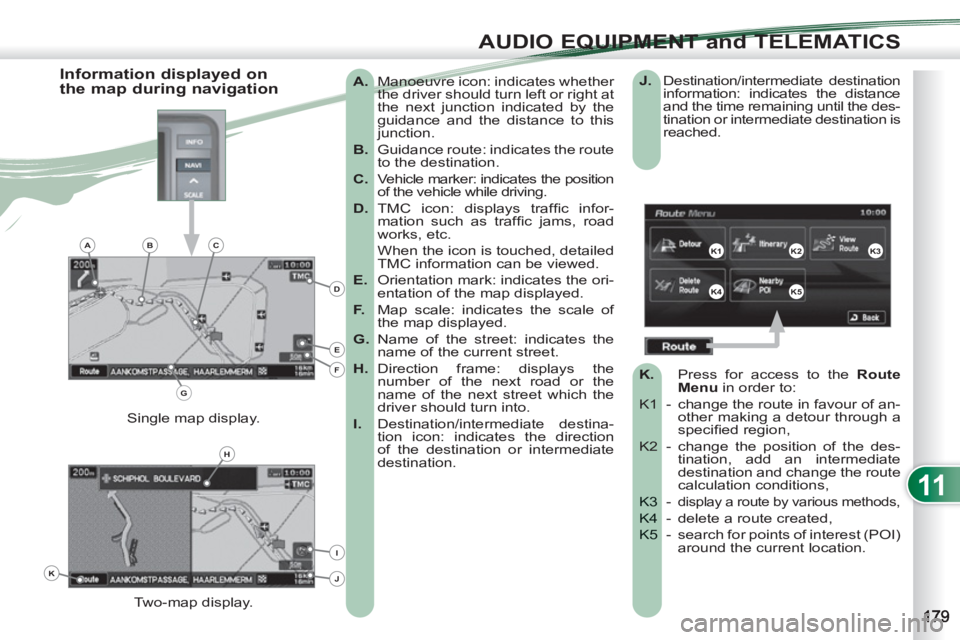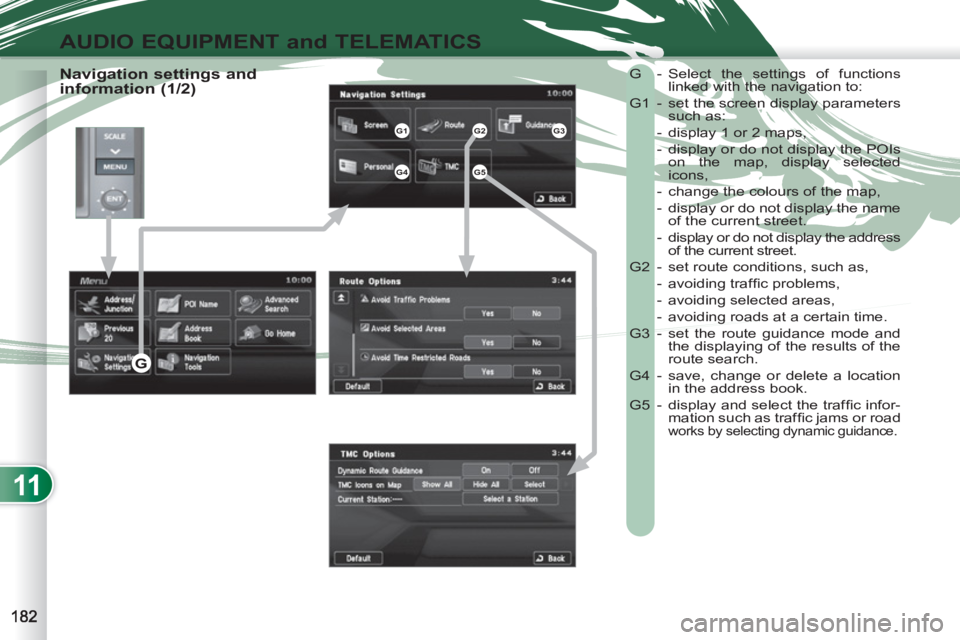2012 PEUGEOT 4007 navigation
[x] Cancel search: navigationPage 180 of 236

11
AUDIO EQUIPMENT and TELEMATICS
NAVIGATION - GUIDANCENAVIGATION - GUIDANCE
What is the navigation system and
the GPS?
The satellite navigation system guides
the driver to the destination that he has
set in accordance with a chosen route.
Initially, it searches for the destination
required by the user, then it calculates
the route and fi nally it provides the visual
and audible guidance instructions.
What precautions should be
observed in order to make best use
of the system?
Do not place anything on or near the
GPS aerial.
Do not use any digital communication
equipment (personal computers, etc.)
near the GPS aerial.
Do not affi x any refl ective fi lms or fi lms
containing carbon to the windows.
The GPS (Global Positioning
System) consists of several
satellites distributed around
the earth. They continuously
transmit digital signals which
travel at the speed of light, on 2 different
frequencies.
At any given time, the system receives
its position in relation to the satellites
detected and the time of transmission
of the signal.
This enables the telematic unit to cal-
culate its position and therefore that of
the vehicle.
A repositioning process using the map
database stored on the hard disk allows
the vehicle to be positioned on the road
network, so improving the accuracy of
the vehicle location function.
What is a point of interest (POI)?
Up to 40 different icons may
be displayed (refer to the
section "Points of interest
icon").
They are classifi ed in 5 groups and
identifi ed by one colour for each group:
- Shops, fi nance and businesses
(Green),
- Vehicles and travel (Dark blue),
- Restaurants (Orange),
- Public places and emergency services
(Brown),
- Entertainment and attractions (Blue).
GPS
The system's measurements may be
inaccurate if the vehicle is:
- in a tunnel or underground car park,
- underneath a two-level motorway,
- in an area with several very high
buildings,
- surrounded by closely planted trees.
Depending on the vehicle's situation and
the reception of the GPS information, the
displayed information may disappear from
the screen temporarily. A point of interest (POI) is
represented by an icon on
the map, it represents an
airport, a station, a town
hall, ...
Page 181 of 236

11
AUDIO EQUIPMENT and TELEMATICS
A.
Manoeuvre icon: indicates whether
the driver should turn left or right at
the next junction indicated by the
guidance and the distance to this
junction.
B.
Guidance route: indicates the route
to the destination.
C.
Vehicle marker: indicates the position
of the vehicle while driving.
D.
TMC icon: displays traffi c infor-
mation such as traffi c jams, road
works, etc.
When the icon is touched, detailed
TMC information can be viewed.
E.
Orientation mark: indicates the ori-
entation of the map displayed.
F.
Map scale: indicates the scale of
the map displayed.
G.
Name of the street: indicates the
name of the current street.
H.
Direction frame: displays the
number of the next road or the
name of the next street which the
driver should turn into.
I.
Destination/intermediate destina-
tion icon: indicates the direction
of the destination or intermediate
destination.
Two-map display. Single map display.
Information displayed on
the map during navigation
J.
Destination/intermediate destination
information: indicates the distance
and the time remaining until the des-
tination or intermediate destination is
reached.
K.
Press
for access to the RouteMenu
in order to:
K1 -
change the route in favour of an-other making a detour through aspecifi ed region,
K2 - cha
nge the position of the des-tination, add an intermediatedestination and change the routecalculation conditions,
- K3 display a route by various methods,
- delete a route created, K4
- search for points of interest (POI)K5 around the current location.
K1K2K3
K4K5
K
H
E
F
BCA
D
G
I
J
Page 184 of 236

11
AUDIO EQUIPMENT and TELEMATICS
Navigation settings and
information (1/2) G - Select the settings of functions
linked with the navigation to:
G1 - set the screen display parameters
such as:
- display 1 or 2 maps,
- display or do not display the POIs
on the map, display selected
icons,
- change the colours of the map,
- display or do not display the name
of the current street.
- display or do not display the address
of the current street.
G2 - set route conditions, such as,
- avoiding traffi c problems,
- avoiding selected areas,
- avoiding roads at a certain time.
G3 - set the route guidance mode and
the displaying of the results of the
route search.
G4 - save, change or delete a location
in the address book.
G5 - display and select the traffi c infor-
mation such as traffi c jams or road
works by selecting dynamic guidance.
G1G2G3
G4G5
G
Page 185 of 236

11
AUDIO EQUIPMENT and TELEMATICS
H - Select basic information relating
to the navigation as well as a pre-
set route demonstration to:
H1 - choose to divert your route to
avoid certain areas,
H2 - select a location using an ad-
vanced search based on a POI
along a motorway or in the vicinity
of the motorway exit,
H3 - start/stop the demonstration,
H4 - recall a stored map screen.
Navigation settings and
information (2/2)
H1H2
H3H4
H
Page 186 of 236

11
AUDIO EQUIPMENT and TELEMATICS
Selecting points of interest (POI)
icons displayed on the map
You can select up to 40 types of point
of interest icon which are displayed on
your map screen.
Press the MENU button then [Navigation/
Settings].
Press [Screen] then [Select] on the POI
line.
Press [4] which is displayed.
Press each POI required.
At each contact with a POI, the display
of [α] changes (α = the POI will be dis-
played on the screen). General
Town centre
Locality
Shops, fi nance and businesses
(Green)
Major companies
Shopping centre
Vehicles and travel
(Dark blue)
PEUGEOT
Airport
Bus stop
Vehicle hire
Suburban station/station
Ferry terminal
Hotel
Park and ride
Car park (press +)
Service station
Rest area
Toll booth
Tourist information
Railway station
Restaurant (Orange)
Night life/night club
Restaurant Public places and emergency
services (Brown)
Town Hall
Community centre
Convention/exhibition centre
Hospital
University/college
Entertainment and attractions
(Blue)
Theme park
Bowling alley
Casino
Cinema
Golf course
Historical monument
Skating rink
Marina
Museum
Flying club
Leisure area
Ski station
Sports centre
Theatre/opera
Tourist attraction
Vineyard/wine and spirit store
Page 188 of 236
![PEUGEOT 4007 2012 Owners Manual 11
AUDIO EQUIPMENT and TELEMATICS
Entering an address and starting guidance (2/2)
Press
Explanations
Result
Press [Street] and enter the name of a street using the touch keypad.
Whe PEUGEOT 4007 2012 Owners Manual 11
AUDIO EQUIPMENT and TELEMATICS
Entering an address and starting guidance (2/2)
Press
Explanations
Result
Press [Street] and enter the name of a street using the touch keypad.
Whe](/manual-img/29/58324/w960_58324-187.png)
11
AUDIO EQUIPMENT and TELEMATICS
Entering an address and starting guidance (2/2)
Press
Explanations
Result
Press [Street] and enter the name of a street using the touch keypad.
When a character of the name of the street is entered, if 5 streets or fewer
are recognised, you can select a street from a list which is displayed or
press [List].
Press [House #] and enter the number of the house using the touch keypad.
You can enter the name of a junction instead of the number
of the street. Press [Junction] and select the name from a
list which is displayed.
This is the result once all of the information has been entered:
If you agree with the information press [Set], otherwise press one of the
buttons to correct.
Press [Start] to start the navigation.
/
Page 189 of 236
![PEUGEOT 4007 2012 Owners Manual 11
AUDIO EQUIPMENT and TELEMATICS
Press
Explanations Result
Press [Route].
Press [Display new route].
The system offers a detour route (dynamic guidance).
Press [Back] and enter to r PEUGEOT 4007 2012 Owners Manual 11
AUDIO EQUIPMENT and TELEMATICS
Press
Explanations Result
Press [Route].
Press [Display new route].
The system offers a detour route (dynamic guidance).
Press [Back] and enter to r](/manual-img/29/58324/w960_58324-188.png)
11
AUDIO EQUIPMENT and TELEMATICS
Press
Explanations Result
Press [Route].
Press [Display new route].
The system offers a detour route (dynamic guidance).
Press [Back] and enter to return to the previous screen.
The system asks you to confi rm or not the new route.
Press [Yes] to confi rm your choice. The system displays the name of the
new route.
Press [No] to not register the route.
Traffic information
During navigation, the system gives you
traffi c information received in real time.
The system can then suggest a detour
route, if dynamic guidance has been
activated by pressing MENU, [Naviga-
tion settings] then [TMC].
Page 194 of 236

11
AUDIO EQUIPMENT and TELEMATICS
CD player
Your Audio-Telematic system allows you
to listen to audio CDs (CDDA, CD-Text,
CD-R/RW) or MP3 and WMA CDs.
Playing an audio CD
When the audio CD is in-
serted in the player, playing
of the tracks is automatic
and they can be recorded
onto the hard disk.
Simultaneous access to the music re-
cognition service "Gracenote CDDB"
on the hard disk permits display of the
title information. Switching off the engine or removing
the CD during recording will result in
the tracks being faulty.
The operation of the navigation system
may slow down during recording.
The recording speed may be slower
than 4x due to the processing load on
the equipment or the condition of the
audio CD.
If jumps or other errors occur, return to
the beginning of the track and start the
recording again.
Even if there is no gap between the
tracks on the CD, a brief silence be-
tween tracks is stored on the hard disk.
What is the Gracenote CDDB?
Copyright
Your Audio equipment may allow you
to listen to music which is usually pro-
tected by copyright in accordance
with current national and international
standards. Please consult these stand-
ards and comply with them.
Recording onto the music server
The tracks of audio CDs (not
MP3/WMA) can be recorded
onto the hard disk at approximately 4x
speed (e.g.: 60 minutes converted to
15 minutes) and stored on the music
server.
The sounds recorded may be altered
by the noise present and the quality of
the sound may differ from the original.
The tracks recorded on the music server
cannot be reproduced on another medi-
um (CD-R/RW, HDD, etc...).
Previously recorded tracks cannot be
recorded again from the same CD. The title information for the
track currently being played
can be obtained from the
"Gracenote CDDB" database
stored on the hard disk.
The Gracenote company uses this
standard to identify the music and the
associated information such as:
- the title of the album,
- the name of the artist,
- the title of the tracks,
- the genre, ...
For further details, consult the site:
www.gracenote.com.
The Gracenote CDDB database incorpo-
rated in this equipment cannot guarantee
the content of the data 100 %. You can
update this database using a DVD sold
separately.